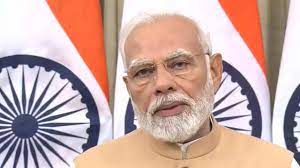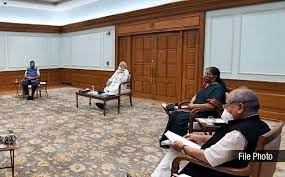
Current Affairs is the most important area in all competitive exams. But the difficulty level is very high. That’s why; many aspirants get confused, how to select Current Affairs for Preparation of Competitive Examination? In this Post, Daily Current Affairs 13 June 2023, we have tried to cover each and every point and also included all important facts from National/ International news that are useful for upcoming competitive examinations such as UPSC, SSC, Railway, State Govt. etc.
So, here is the Top News of the Day for 13 June 2023 to help you prepare the Latest Current Affairs part. After reading this section, you can successfully attempt Current Affairs Quiz.
Current Affairs for Competitive Exam – 13 June 2023
ICC Player Of The Month For May 2023 Revealed

Harry Tector has been named the ICC Men’s Player of the Month for May, making him Ireland’s first winner of the accolade. He emerged victorious in a tough competition against the renowned Pakistani cricketer Babar Azam and Bangladesh’s promising young batter Najmul Hossain Shanto. Thipatcha Putthawong (Thailand), a brilliant 19-year-old player, was named the ICC Women’s Player of the Month for May 2023. She follows in the footsteps of her countryman Naruemol Chaiwai, who received the prize last month.
Both players were selected as the standout performers following a vote conducted among a specialist panel comprising ICC Hall of Famers, former international players, and media representatives, and global cricket fans registered at icc-cricket.com, who had been voting since the nominees were announced last week.
Important points
- Tector has been enjoying a sustained period of good batting form in One-Day International (ODI) cricket dating back to July 2022, and his recent run-scoring feats have seen him shoot up to a highest-ever position of seventh spot in the MRF Tyres ICC Men’s ODI batting rankings.
- Thipatcha Putthawong, Thailand’s new ICC Women’s Player of the Month, got the accolade after a string of excellent bowling figures in her country’s gold-medal winning effort at the Southeast Asian (SEA) Games in Phnom Penh, Cambodia, in May. The left-armer took 11 wickets in four T20Is during the performance period at a staggering average of 1.54, enjoying successive spells of four wickets for three runs, three for three, and three for two against the Philippines, Malaysia and Myanmar respectively in Thailand’s surge to gold.
Important takeaways for all competitive exams:
- ICC Founded: 15 June 1909;
- ICC Headquarters: Dubai, United Arab Emirates;
- ICC Chairman: Greg Barclay.
The Withdrawal Of ₹2000 Notes In India: What You Need To Know

As part of its Clean Note Policy, the Reserve Bank of India (RBI) announced the withdrawal of 2000 currency notes from circulation on May 19, 2023. Unlike the previous note ban, the government has given the public adequate time to deposit these notes with banks. This article highlights the reasons for the withdrawal, the process of exchanging or depositing ₹2000 notes, the exchange limit, the impact on the economy, and provides an overview of demonetization and legal tender in India.
Reasons for the Withdrawal of ₹2000 Notes:
- Introduction during demonetization: The 2000 note was created as part of demonetization in November 2016 to replace the removed 500 and 1000 notes. Demonetization aimed to tackle issues such as black money, corruption, tax evasion, and promote digital transactions.
- Achieving sufficient money circulation: Once the objective of ensuring adequate money circulation in the economy was achieved, the printing of ₹2000 notes was stopped in 2018-19.
- Decreased transactions and digitization: The recent surge in digitization and reduced usage of high-value currency notes contributed to the decision to withdraw ₹2000 notes.
- Lifespan of notes: The majority of ₹2000 notes in circulation were issued prior to March 2017 and have reached their estimated lifespan of 4-5 years. As per the Clean Note Policy, the RBI aims to maintain good quality currency notes.
Process of Exchanging ₹2000 Notes:
The Withdrawal of ₹2000 Notes in India: What You Need To Know
- Deadline and legal tender status: The deposit deadline for 2000 notes in banks is September 30, 2023. However, these notes will remain legal tender long after the deadline.
- Depositing and exchanging: Individuals can approach any bank, regardless of whether they hold an account there, to deposit or exchange ₹2000 notes.
- Compliance and encashment: Deposits can be made in the usual manner, subject to compliance with Know Your Customer (KYC) norms and other statutory requirements. The encashment of deposited ₹2000 notes can be done later.
- RBI Regional Offices: Currency exchange facilities are available at the 19 RBI Regional Offices with Issue Departments.
₹2000 Note Exchange Limit:
- Exchange limit: Any bank can exchange 2000 notes for other denomination banknotes up to a limit of 20,000/- at a time. This service is provided at no cost.
- No limit for deposits: There is no limit for depositing ₹2000 notes into bank accounts, subject to compliance with KYC and other regulatory requirements.
Impact and Rationale:
- Marginal impact on the economy: The withdrawal of ₹2000 notes will have a minimal impact as they constitute only 10.8% of the total currency in circulation.
- Adequate availability of other denominations: The economy has a sufficient supply of banknotes in other denominations, ensuring no disruption in normal life or the economy.
- Boosting bank deposits: The withdrawal could result in greater bank deposits, which would boost credit growth and potentially moderate short-term interest rates.
- Curbing black money and corruption: The withdrawal aligns with efforts to curb black money and corruption by promoting transparency and formalizing the economy.
RBI’s Clean Note Policy:
The Clean Note Policy focuses on providing the public with currency notes and coins that have enhanced security features while gradually phasing out old or soiled notes. It ensures that older banknotes, issued before 2005, are withdrawn from circulation to align with international practices.
Demonetization in India:
- Definition and legal basis: Demonetization refers to the act of stripping a currency unit of its status as legal tender. Demonetization in India is controlled by Section 26(2) of the RBI Act, 1934, which authorises the government to declare banknotes no longer legal currency.
- Advantages: Demonetization aims to stabilize currency, fight inflation, curb counterfeiting, promote digitization, formalize the economy, increase tax revenues, and reduce corruption and crime.
- Disadvantages: The process can temporarily slow down economic activity, involve administrative costs, and impact cash-driven sectors.
Legal Tender in India:
- Definition and types: Legal tender refers to currency recognized by law as an acceptable means of settling debts or obligations. Coins with denominations equal to or higher than one rupee and banknotes are considered legal tender in India.
- Limits and regulations: Certain limits, such as the amount of cash transactions, may be imposed to curb black money. The government issues coins, including the ₹1 coin, while the RBI issues all other currency notes.
First Barge Of The Series Lsam 15 Delivered To Indian Navy

First Barge of the series LSAM 15 delivered to Indian Navy
- The first barge in the series LSAM 15 (Yard 125) was delivered to the Indian Navy under the Contract for Construction of Ammunition Cum Torpedo Cum Missile (ACTCM) Barges with M/s Suryadipta Projects Pvt Ltd, Thane, an MSME.
- The deal was established under ‘Aatmanirbhar Bharat’ initiatives of the Government of India
- A total of eleven such barges are under construction which when ready will be delivered to the Indian Navy.
Significance
- The barge was built in accordance with Indian Register of Shipping (IRS) classification requirements and has a service life of 30 years.
- With all major/auxiliary equipment sourced from indigenous manufacturers, the Barge is proud flag bearer of “Make in India” initiative of Ministry of Defence.
Role
Induction of (Ammunition Cum Torpedo Cum Missile)ACTCM Barges will provide impetus to Operational commitments of Indian navy by facilitating Transportation, Embarkation and Disembarkation of articles/ ammunition to Indian navy Ships both alongside jetties and at outer harbours
Twin CBG Operation: INS Vikramaditya, Vikrant lead Navy’s mega ops in Arabian Sea

INS Vikramaditya, Vikrant lead Navy’s mega ops in Arabian Sea in Twin CBG operation
As part of a Carrier Battle Group (CBG), the Indian Navy conducted a large operation in the Arabian Sea involving more than 35 aircraft. This was one of the most significant demonstrations of the Navy’s operational capabilities to date, and comes at a time when there are increasing Chinese forays into the Indian Ocean.
Twin CBG operation: Key Points
● A CBG is a naval fleet comprising an aircraft carrier and multiple escort vessels.
● Both of India’s aircraft carriers, INS Vikramaditya and INS Vikrant, as well as a diversified array of escort ships, submarines, and planes, were involved in this dual CBG operation.
● The primary purpose of the exercise was to showcase India’s commitment to safeguarding its national interests and maintaining regional stability.
● The Navy also emphasised that the exercise was a significant milestone in enhancing its maritime security and power-projection in the Indian Ocean and beyond.
● The exercise demonstrated the critical significance of sea-based air power in sustaining maritime superiority.
● Furthermore, the Navy is considering a third aircraft carrier and is discussing the feasibility of a repeat order of INS Vikrant, India’s first indigenous aircraft carrier.
Sarbananda sonowal launches ‘sagar samriddhi’

SAGAR SAMRIDDHI
Sarbananda Sonowal, Union Minister of Ports, Shipping, and Waterways, introduced the ‘Sagar Samriddhi’ online dredge monitoring system as part of the ministry’s ‘Waste to Wealth’ initiative. The National Technology Centre for Ports, Waterways and Coasts (NTCPWC) developed the system, which replaces the old Draft and Loading Monitor system and offers improved efficiency and transparency.
SAGAR SAMRIDDHI: Key Points
- In addition, the Ministry of Ports, Shipping, and Waterways updated its ‘Dredging Guidelines for Major Ports’ to outline the planning and preparation, technical investigations, dredged material management, and cost estimation procedures for dredging projects, including enabling ports to formulate and complete them within specified timelines.
- The ministry issued an addendum in March 2023 for the disposal of dredged material, which would reduce the cost of dredging, and the online system would facilitate cost reduction along with increased efficiency and transparency.
SAGAR SAMRIDDHI: Aim
The ministry aims to develop major ports into trans-shipment hubs with deep drafts of over 18 meters as part of its Maritime India Vision 2030.
About NTCPWC’:
- The NTCPWC’ establishment under the Sagarmala Programme of MoPSW has invested INR 77 crores, and it aims to promote research and development for the marine sector to create a robust marine industry in India.
- The centre is dedicated to fostering marine industry research and development, with the ultimate goal of developing a strong marine sector in the country.
- Equipped with state-of-the-art 2D and 3D investigation capabilities, the centre offers top-notch research and consultancy services for the Port, Coastal, and Waterways sector in all disciplines.
- The centre’s expertise lies in a range of areas, including Ocean modelling, Coastal & Estuarine Flows, Sediment transport and morph dynamics, Navigation and Manoeuvring planning, Dredging and Siltation estimation, Port and Coastal Engineering consultancy, designing Structures and Breakwaters, Autonomous Platforms and vehicles, Experimental and CFD modelling of flow and Hull interaction, Hydrodynamics of multiple hulls, and Ocean renewable energy coupled with port facilities.
The centre has already made significant contributions in enhancing the marine sector’s optimisation capabilities. The laboratories at the centre are among the best in comparison to other international labs in the Ministry’s specific domain.
Kilauea Volcano Erupts On Hawaii’s Big Island

Kilauea volcano eruption:
The US Geological Survey (USGS) has downgraded the safety alert for Kilauea volcano in Hawaii, following a new eruption. The alert level has been dropped from “WARNING” to “WATCH” since effusion rates have decreased and there is no threat to infrastructure. The previous warning has been lowered to a watch, as high effusion rates have decreased and no infrastructure is considered to be under threat. Aviation warnings have shifted from red to orange also.
Kilauea volcano eruption: Key Points
- Aviation warnings have also been reduced from red to orange. Kilauea, one of the world’s most active volcanoes, is located in a closed national park on the Big Island of Hawaii.
- The ongoing eruption is expected to persist, however, lava flows will continue to be limited to the crater and summit of the volcano.
- Hawaiians are asking tourists to observe the volcano’s eruption from a respectful distance.
While lava flows are expected to remain confined to the surrounding crater and summit, USGS predicts that the eruption will continue.
Kilauea volcano: About
- Kīlauea is a volcano on the southeastern shore of Hawaii’s Big Island.
- • It originated between 210,000 and 280,000 years ago and is around 100,000 years old.
- Along with four other volcanoes, it comprises the island of Hawaii.
- Kīlauea is the most active of the five and one of the most active in the world, with recent eruptions in 2021 and 2023.
- Initially considered a satellite of its larger neighbor Mauna Loa, Kīlauea has its own structures, including a summit caldera and two active rift zones extending east and west.
- Halemaumau pit crater has an active lava lake, while Klauea saw practically constant eruptions from vents on its eastern rift zone between 1983 and 2018.
- In 2018, activity shifted to the lower Puna district, destroying hundreds of dwellings, Hawaii’s largest natural freshwater lake, and several communities.
- The eruption also prompted the closure of the Kīlauea section of Hawaii Volcanoes National Park. Kīlauea erupted again in 2020 and 2021, draining a water lake to create a lava lake in the Halemaʻumaʻu crater.
Indigo Ceo Pieter Elbers Appointed As Chair-Elect Of Iata’s Board Of Governors

IndiGo announced that its CEO, Pieter Elbers, has been elected as the chair-elect of the International Air Transport Association (IATA) Board of Governors. With effect from June 2024, he will succeed the current Chair, Yvonne Manzi Makolo, as CEO of Rwandair. The nomination of Pieter Elbers comes at an important time for the Indian aviation industry, which is witnessing unparalleled growth and development.
With a focus on enhancing the passenger experience, IndiGo has consistently demonstrated its commitment to affordable fares, on-time performance, and courteous and hassle-free services across its unparalleled network, it said. Pieter Elbers’ appointment reinforces IndiGo’s position as a driving force in the Indian aviation landscape while placing India firmly on the global aviation map.
The International Air Transport group (IATA) was created in 1945 as a trade group for the world’s airlines. It has 300 members, accounting for 83% of total aviation traffic. The headquarters of IATA are in Montreal, Canada.
IATA provides a range of services to its members, including
- Setting standards for air travel, such as safety, security, and passenger rights
- Developing and managing airfares and ticketing systems
- Providing training and education for airline staff
- Representing the interests of the airline industry to governments and other organizations
IATA also works to ensure that the air transport business grows in a safe and sustainable manner. IATA started its “Fly Net Zero” campaign in 2020, with the goal of achieving net zero carbon emissions from aviation by 2050.
IATA is a non-profit organization and its activities are funded by its members. It is governed by a board of directors and a general assembly.
Here are some of the key activities of IATA
- Setting standards: IATA sets standards for a wide range of aspects of air travel, including safety, security, and passenger rights. These standards are used by airlines to ensure that they operate safely and efficiently.
- Developing and managing airfares and ticketing systems: IATA creates and oversees global airfare and ticketing systems that airlines use to sell tickets to passengers. These methods ensure that passengers can book tickets with any airline and pay the same price for the same flight regardless of where they purchase the ticket.
- Providing training and education: IATA provides training and education to airline staff on a wide range of topics, including safety, security, and customer service. This training helps to ensure that airline staff are able to operate safely and efficiently and that they can provide passengers with a high level of service.
- Representing the interests of the airline industry: IATA advocates the airline industry’s interests to governments and other organisations. This includes pushing for legislation that benefit the aviation sector and attempting to resolve industry-related difficulties.
- Promoting the safe and sustainable growth of the air transport industry: IATA is committed to promoting the safe and sustainable growth of the air transport industry. This includes working to reduce emissions from aviation, improve air traffic management, and develop new technologies that can make air travel more efficient.
Unemployment Rate Falls To 7.7% In May On Decline In Labour Participate

According to data released by the private economic think tank CMIE, the unemployment rate in India fell to 7.7% in May due to a decline in labor participation at 441.9 million.
The unemployment rate in India among people aged 15 years and above fell to 7.7% in May 2023, from 8.5% in the previous month.
The urban labour market recorded a fall in the number of employed as well as unemployed people.
The rural labour force reduced to 299.4 million in May.
IIT Mandi Researchers Develop Smart Biodegradable Microgels

Researchers at the IIT Mandi have developed smart biodegradable microgels to make agricultural practices more sustainable and minimize the adverse impact caused by the use of insecticides and agrochemicals
The research has been published in the “Carbohydrate Polymers” journal.
Modern agriculture relies heavily on the application of various agrochemicals such as insecticides, herbicides, and fertilizers on crops to meet the demand for food for the growing population.
Axis Bank’s Lake Cleanliness Drive In Hyderabad Enters Asia Book Of Rec

Axis Bank in partnership with NGO Dhruvansh has organised a lake cleaning drive, ‘Cleanathon’, in Hyderabad.
This initiative was recorded in the Asia Book of Record as it was the largest cleaning drive conducted across the country.
In Hyderabad, over 100 volunteers participated in cleaning Mushki Cheruvu and Neknampur Lake to restore these water bodies. The campaign aligned with the United Nations’ theme for World Environment Day 2023, ‘Beat Plastic Pollution’.





